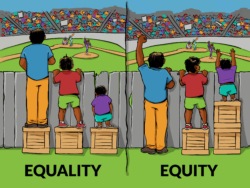Think again. The Equality v. Equity slide
Think again. The Equality v. Equity slide
By: Justin Laing | August 17, 2019 | Diversity Inclusion Equity

Biologically rooted inequality
I am going to be moving to this page posts I’ve written in the past but did not make it over when I changed websites. This was written in 2016, but the slide recently came up in a project I was working on and so I am thinking it’s still relevant.
Writing or thinking about some question on equity recently that involved the need to think about history, the “equality/equity” slide above flashed to my mind. If you are a follower of conversations on equity, the image is likely familiar to you: three people of three different heights are all positioned at a fence, standing on a box and watching a baseball game. The two taller figures on the left are able to see over the fence to see the game, but the one on the right is stuck looking directly into the fence because the height of the box is not enough to get his head above the top of the fence. The idea in this frame is that they are all being treated equally, in that they are each standing on a box, but they are having disparate outcomes in that one of them is not able to see the game, even with the help of the box. In the 2nd frame, the shortest of the three is now standing on two boxes and this allows them to see, the middle person is still standing on one and can still see and the tallest is now not standing on a box, but can still see because of how tall they are. The difference between the first frame and the second frame is in the outcome. Now all can see over the fence because the shortest person is standing on the box that the tallest did not need in order to see the game. How that transaction of box giving happened, we are not sure, although I always assume that the tallest person gave his box to the slump shouldered shortest person, particularly since I’ve seen this image as one of descending ages aligned with descending heights.
The image is very popular as an explanation of how treating people equally can still lead to inequitable outcomes and that equity is about assuring equal outcomes not equal treatment. It was recently redone by the Interaction Institute and artist Angus Maguire (I tweeted about this recently without giving the artist or organization credit. Apologies!) and in the two years since the original was first created by Craig Froehle, it has had quite the evolution. Of course, there are only two words “Equality” and “Equity” embedded in this picture and so much must be inferred, but this is the intent, right? Make us think. Now, that’s some background on the image, but what I want to reflect on is what is not in the image and how this missing information is emblematic of our racial equity conversation: We don’t see any representation of history that has lead to inequity and we don’t see the tension that is all over these conversations of redistribution. As I work in the non-profit arts sector, I will look at this image through the lens of the arts, but the arts touch everything and I think these ideas apply to other sectors as well.
As, I say above, what is not in the image is a frame or two or three about how our arts landscape came to be inequitable in the first place. Whether a report from the Devos Institute, Diversity and the Arts, Grantmakers in the Arts’ Racial Equity in Philanthropy Statement of Purpose or even the rationale for a program funded by The Heinz Endowments and The Pittsburgh Foundation, Advancing Black Arts in Pittsburgh, it is clearly established that we have an inequitable, and by this I mean unfair, arts landscape when it comes to ALAANA artists, organizations, audiences and communities having the financial means to create and experience art as compared to white artists, organizations, audiences and communities. If we look at the image initially created by Froehle, and apply it to the arts landscape, we would understand this inequity to mean white arts organizations were simply naturally at a larger scale because of their DNA, or maybe they were just born earlier (although Froehle says that his image was designed to show youth of different heights). However, we know from reports such as the National Committee for Responsive Philanthropy’s Fusing Art, Culture and Social Change that in the late 19th century arts philanthropy began supporting art of the white western canon and did not begin supporting “community” arts until the 1960s, which is about the same time philanthropy began capitalizing orchestras in many large U.S cities. Around the same time the National Endowment for the Arts was born as was the state arts agency model and government arts funding priorities looked much like philanthropy’s. I serve on the PA Council on the Arts and when I look at the 100 largest budget organizations in the state, I see 4 that would be considered ALAANA led. The National Large Western canon organizations and art forms are not simply taller. They were cultivated for ‘height’. ALAANA arts organizations are not simply shorter. They were not given access to the same resources to grow.
Staying with this image, and moving beyond how the larger predominantly white arts organizations got tall to the boxes they are standing on, what would it be to take one box away from them? What is this thing that can be taken away and causes them no less of a “view” and simultaneously provides a full view for the ALAANA arts organization? This is where the “Equality/Equity” slide greatly oversimplifies the problem we face, because as I think about the conversations I am involved in, this unneeded box doesn’t exist on the side of the predominantly white arts organization, and one box isn’t tall enough to get the heads of “shorter” ALAANA organizations over the fence. Of course, this issue is only compounded by the fact that many of the predominantly white arts organizations may not really have their heads over the fence either and that is a whole other issue that is not limited to the non- profit arts sector. The image does not reflect the issue of how competition for scarce resources is fundamental to the capitalist economic mode. So, feel like we need an image that shows on one end the history that has lead to inequity, the negotiation among the various “box providers”, the process of redistribution & the discomfort that is a part of this process and then more equitable outcome. Then we need some symbol for lather, rinse, repeat. We know from the history of racial inequity that this will not be done in one neat step and so don’t we need symbols that when it gets rocky and tense that remind us this is how it is supposed to happen and will need to keep happening if we are going to really build a fair or equitable landscape?
